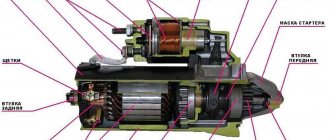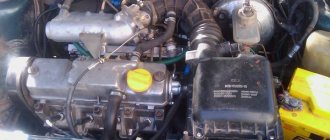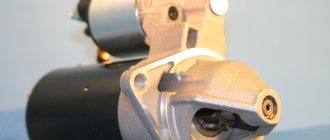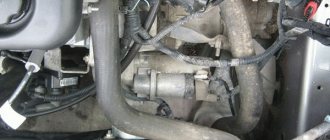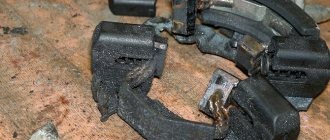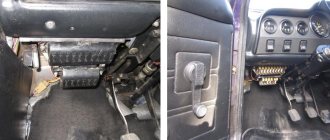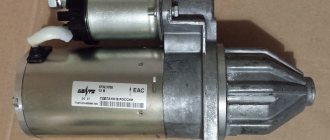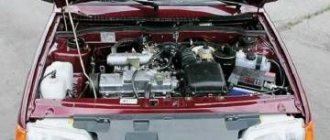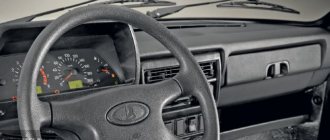The wiring diagram for hatchbacks 2112 is a unique thing in itself. In order for voltage to appear on the solenoid relay, the following parts must be in good working order: the ignition switch, the ECU unit and two more relays - the main and additional ones. Some cars do not have an additional relay, which can be considered good luck. But, if when you turn the key on a VAZ-2112 the starter does not turn, then the fault must be looked for in the wiring. A broken immobilizer code can also cause problems. The last malfunction can be cured by replacing the ECU or disabling the immobilizer. Well, let's look at something simpler.
Example in the video: the immobilizer was damaged and the starter stopped working.
All features of the standard scheme
The reader will be surprised, but there will be more than one scheme here. The most difficult option is shown below.
Scheme with an additional starter relay Please note: relay K2 is not at all “unloading”. A significant current flows through the lock contacts, and relay K2 can be called “blocking”: when it does not work, the starter does not turn. Why is this necessary, think for yourself.
If an attacker closes the contacts in the lock, he will not only be unable to start the engine, but also not use the starter. That is, the hijacker will not drain our battery. The circuit shown above is used with 1.6 liter injection engines. There may be another option - a simpler one.
Circuit without additional relay There is no blocking relay here. The current flows to the solenoid relay from pin 50. A simple version of the circuit is typical for cars from early years of production. Which applies to the entire “Ten” family, including hatchbacks. That is, an interesting combination occurs: the model is VAZ-2112, and the starter will turn even in the absence of all relays and ECUs!
Causes of frequent problems with the starter
As practice shows, the most common problems with the starter appear in the electrical part.
When your car won't start, the first thing you need to do is check the battery. The starter is powered only from the battery. If the battery is discharged and does not produce the required voltage, then even clicks will not be heard. If your car has a tester, you can check if the battery charge is correct. Simply turning on the headlights will help replace it; an experienced driver can understand the degree of dilution of the battery based on the lighting power. You can also twist the fasteners on the battery terminals if you suspect low voltage.
The starter doesn't turn, what happens?
We know that there are two variants of the scheme. If “option 2” is implemented, voltage to the starter is supplied directly from the lock. But the ignition switch in the “Tens” is short-lived, since 30-40 Amperes are transmitted through it (the current of the solenoid relay).
This is true for both the sedan and the 2112 hatchback, and the starter may not turn only because the lock is broken. Draw your conclusions!
All of the above also applies to “diagram 1” - look at it carefully. The main relay is located in the extension block. It is located under the stove on the right.
An additional relay is located in the main unit (see photo). However, it may be missing.
If “option 2” is implemented, check only the lock. And if there is an additional relay, it is not recommended to install a jumper instead. Marked in the photo:
- Additional relay (white arrow);
- Main relay (element “6”).
Possible starter malfunctions: causes and symptoms
Main components of the mechanism
So, first, let's look at the faults that cause the starter to not turn on a VAZ 2112.
If the engine does not start, it does not mean that the problem lies in this particular device, so first you need to make sure that the problem does not lie in a discharged battery:
- If, when trying to start the VAZ 2111 starter with the key, the crankshaft turns once or frequent clicks of the device are heard, this is indicative of a low battery. Also, the reason may be poor contact of the terminals with the battery or disconnection or poor contact of the mechanism ground.
- If, when starting the engine with the key, you heard only one click, but the starter does not turn, and therefore the engine does not start, most likely the problem lies in burnt power contacts. In particular, we are talking about the retractor relay mechanism. Due to burning, these contacts will not be able to conduct voltage through them. It also happens that when starting the engine with the key on a VAZ 2112, the starter does not turn, but the contacts are intact; if this is the case, then the reason should be sought in the non-working electric motor of the mechanism or its drive.
- The appearance of uncharacteristic noise during operation of the device may be due to wear of the bushings of the bearing devices. In addition, the reason may lie in the wear of the journals on the armature shaft.
- It is necessary to check the quality of fastening of the device. It is quite possible that problems in its performance are due to loosening of the screws. It must be taken into account that vibrations can negatively affect the functionality of the mechanism.
- The reason may also be damage to the drive teeth (the author of the video is the Lexin channel).
Final check before replacing the starter
We turn the key to position II, and nothing happens... In this case, open the hood and remove the air filter by unscrewing the screw on the body and loosening the clamp on the pipe. The starter is located under the filter housing. In the photo we see the following: someone disconnected the solenoid relay cord.
What we found under the filter, we check with a needle probe that when you turn the key, “+12” appears. Then, after checking, we wrap the cord with electrical tape.
Sometimes voltage seems to be supplied to the starter, but the solenoid relay is activated “every time”. Well, try cleaning the terminal - both in the connector and on the starter itself. Consider the situation:
- The copper is polished to a shine;
- The wire (see photo) is supplied with “plus”;
- The starter doesn't even click.
The first thing you need to check is the battery contacts. We remove the terminals (key “10”) and look at what is under them. There is no point in measuring the voltage with a probe - it will show “12 Volts”.
Solenoid relay current – 40 Amperes. The presence of a resistance of 0.1 Ohm results in a voltage drop of 4 Volts. So consider... And the starter motor consumes 200 Amperes during operation.
Relay test
In addition to problems associated with the relay, the cause sometimes lies in a malfunction of the control cable. You can find out by directly connecting the starter terminal to the positive terminal of the battery through a wire of a smaller cross-section. After connecting this connection, a problem in the starter will be detected. If not, then you should check the relay and ignition contacts.
Weak contact on the connections is not able to ensure the normal passage of electric current in full, so it makes sense to check all connections, especially in the power cable. For normal operation of the starter, 200 A is required. If the voltage is slightly lower than this indicator, then it will only be enough to start the retractor winding, the sign of which will be a click, but the car will not start.
Why doesn't the starter turn over?
Depending on what caused the starter to fail, it is necessary to take the next steps - repair or replace the unit. In addition, in some cases, you do not need to repair the starting device itself, but manipulate other components. In most cases, you can get by with repairs, but experienced car enthusiasts recommend immediately replacing the unit so that there are no more problems with it.
- Most VAZ-2110s do not have a standard injector, but many car enthusiasts install this unit themselves. It helps reduce fuel consumption, helps start the engine in cold weather without warming up and increases power. The injector fails, and along with it the starter, due to low-quality fuel. Another reason may be failure to follow the connection diagram, but then you will discover a malfunction immediately after installing the injector. Otherwise, you need to flush the injector to remove any suspended matter that is carried into it by the fuel.
- If the car starts, but after a short stop the engine cannot be restarted, then the problem lies in the overrunning clutch. At the moment of failure, you may hear clicking sounds from under the hood and notice that the car radio begins to turn on by itself. In this case, you need to cool the power unit before restarting or not make short stops. You will also need to replace the overrunning clutch with its geared counterpart. Be sure to check the conductors that come from this node. Sometimes, to restore the functionality of the coupling, it is enough to replace the wires that visually look damaged.
- The retractor part of the starter especially often fails. When such a breakdown occurs, the dashboard lights first light up and then go out. Before replacing the solenoid relay, you must close the starter and turn off the alarm. If the listed components are in working order, then you will simply have to replace the relay.
- Clicking sounds in the starter and failure to start the engine are often caused by damaged contacts. In this case, first inspect the battery, clean the terminals if oxide appears on them. Sometimes on a VAZ-2110 it is enough to tap the starter relay to get rid of the problem. Be sure to take an assistant with you who will start the engine while you tap the relay. If with such a rough approach it was possible to start the engine, then it is worth replacing the relay completely. Repair will be impractical.
- An unexpected engine stop is caused by problems with the immobilizer. You will not be able to start the engine because the protection is triggered. This only happens on injection VAZ-2110s. It is impossible to fix the problem on your own; call a tow truck and go to the nearest service station, where they will be able to restore your car’s functionality.
Popular causes of malfunction
The most common reasons account for about 95% of all cases when the starter does not turn. That’s why we pay attention to them first.
The starter does not turn differently in different situations. It is important to take this into account and clearly monitor all associated symptoms. So, even without the help of specialists, you will be able to return the unit to operation and resume normal operation of the ignition system
| Situation | Probable Causes |
| There is one click, after which the starter goes silent. |
|
| Multiple clicks occur in succession |
|
| Clicks are completely absent, as are other signs of starter life. |
|
Bendix
Often, simply disassembling and cleaning the internal components of the starter can eliminate problems with its functionality. Therefore, after removing the device and not finding damaged elements inside it, try to thoroughly clean everything, assemble it and put it back in place. It is likely that the starter will start turning.
How to accurately determine that the starter needs to be replaced
It is not always worth wasting your time to fix a faulty starting device with minor or partial repairs. Large-scale troubleshooting is often impractical at this site. Before removing, let alone disassembling, the starter, you need to remember three signs when you should rush to purchase new spare parts:
- When you turn the key in the ignition, you hear a grinding noise in the engine compartment area. This directly indicates a malfunction of the bendix (overrunning clutch) or flywheel. It is these parts that need to be replaced.
- Clicking noises when the starter fails to operate means the relay is faulty.
- A strained engine start is evidence of failure of the starter brushes.
The most common cause of clicking sounds in the starter is considered to be a failure of the retractor. The relay is not that expensive, and you can also try to fix it yourself. This will require a lot of effort, but will save you from replacing the unit. Just remember that this is a temporary measure, the restored relay will not be enough for a long time, and in some cases the bulkhead will not help.
Under the relay body you can find the armature, coil, rod and contacts. Most often, oxide appears on parts of this device, which is time to try to clean. However, it is worth remembering that this measure is sometimes ineffective. Therefore, it is best to immediately buy a new spare part.
Causes of starter failure
The engine crankshaft rotates by creating the required starter torque. It is a kind of DC electric motor.
If it turns out that the starter does not turn, it is necessary to determine the cause of the breakdown and understand what exactly malfunctions in the engine starting system are characterized by.
Sometimes the starter does not turn or click due to disconnected peripheral devices. In this case, you also do not need to discharge the battery and start looking for the problem.
Lack of sufficient charge in the battery
When considering the reason why the starter does not respond to turning the ignition key, most often motorists focus on the lack of power. The battery is either disconnected or low. If this is really the reason, you won’t get any signs of life from the starter.
If a problem with the battery is confirmed, you need to carefully check the terminals on the battery. Often the lack of power occurs due to an insufficiently strong connection.
Malfunction of the electrical circuit of the ignition system
If the starter does not turn, but checking the battery does not show any malfunctions, you should look for reasons elsewhere. Breaks in the wiring are often to blame for the problem, that is, the electrical wires either spark when the engine starts, or they are completely disconnected from the battery.
Often the same problem occurs due to oxidized terminals. This “disease” is typical for batteries of any model.
Solenoid relay malfunction
In some cases, the starter solenoid relay clicks, but the circuit does not close. Sometimes you can save yourself by closing the contacts, but not always. If a characteristic cracking sound is heard in the engine area, the bendix is likely to break.
Bendix is easy to recognize. It looks like a small gear located on the rotor shaft. When voltage is applied to the bendix, a relay starts to operate, which controls its movement, engaging with the flywheel.
If the bendix is worn, the entire procedure described becomes impossible, since the relationship between the part and the flywheel teeth will not be achieved. The impossibility of this procedure provides the characteristic crunch.
Starter malfunction
Although most often the reason that the starter does not turn is a lack of energy and a lack of charge in the battery, often the reason lies in the engine starting part itself.
In this situation, identifying and eliminating the malfunction will take much more time and effort. Common launcher problems include:
- if there is a burning smell or the starter is smoking, it is possible that the winding burned out when shorted;
- breakdown of the electrical system of the starting device;
- failure of the solenoid relay;
- Bendix teeth worn out;
- contacts are damaged;
- wires burned out.
Usually, when the starter clicks but does not turn, it is sent to a service center for repair, but repair is not always possible. For example, if the cause of the malfunction is a breakdown of the solenoid relay or a malfunction of the bendix, repairing the device is possible. If there is a problem with the electrical system, the starter will probably have to be replaced.
Incorrect alarm operation
How to start a car if the starter does not turn, if everything is in order, the battery is charged, and the wiring is not damaged? There is a possibility of disruptions during operation as a result of malfunctions of car alarms and immobilizers.
The nature of the faults does not depend on the car model, make and year of manufacture. Here attention should be paid to how complex the anti-theft device is installed.
A characteristic factor of the presence of a problem in the anti-theft device is that the car does not start, the starter does not turn, the relay does not click. Or the car starts, but immediately stalls. The engine does not respond to starting with the key, and does not start with the key fob. If all of these factors, or selectively, are present, then either a complete or partial blockage of the system has occurred.
Brushes and winding
Inside the starter housing there are 4 steel cores (shoes) with a winding that is connected into a circuit.
Healthy! Some cars do not use cores with windings, but magnets, which is much more convenient.
The current to the winding comes from the central input, and the output is output to two copper-graphite positive brushes that go to the commutator. Also connected to it are negative brushes that come from the starter mass. All brushes are constantly pressed using small springs. But, since graphite is not the most durable material, these elements tend to wear out quite quickly. When brush wear reaches a critical level, the solenoid relay stops receiving current.
In the event of such a breakdown, the starter will not make any extraneous sounds. To repair, you will need to disassemble it and evaluate the condition of the brushes. If everything is in order with them, then we look at the windings. If they burn out, the layer of varnish that is applied to them will also burn out. Also, instead of copper color, the windings will be black. An unpleasant burning smell also indicates a problem. In this case, the best thing would be to replace the entire assembly, although you can get by with new windings.
How to quickly close the starter with a screwdriver or other means
What to do if the screen on your phone is cracked. What to do if your laptop screen is broken
Many motorists have to deal with problems related to the vehicle starter at least once in their lives. The starter stubbornly refuses to work as before, although it itself is not damaged (the solenoid relay becomes the problem). We will look at what to do in this case and how to revive the starter in our article. There is Murphy’s law, known to all people on earth, as it is also popularly called the law of meanness. The car breaks down at the most inopportune moment, when you urgently need to go somewhere, and time is running out. In this case, there is nothing left to do but close the starter contacts in order to revive this important element of the car.
DIY mechanism repair and replacement
If the power unit does not start, it is necessary to repair the VAZ starter.
This procedure looks like this:
- First of all, you should disconnect the battery, and then disconnect the wires connected to the traction relay.
- Using a 13mm wrench, you will need to unscrew the nut that secures the positive contact of the cable connected from the battery to the starter assembly. The wire itself can then be dismantled.
- Next, you will need to unscrew the nuts that secure the mechanism to the clutch housing. To unscrew the nuts you will need a 15mm wrench.
- After completing these steps, the starter assembly can be removed. If you plan to replace it with a new one, then the replacement can be done at this stage. When replacing, you need to take into account the location of the wires connected to the starter; under no circumstances should they be mixed up. Therefore, before disconnecting the wires, it is advisable to mark them. If you do not want to change the mechanism, but plan to repair it, then you can start disassembling it.
- To disassemble, you will need a 10mm wrench; you can use it to unscrew the nut located on the relay and remove the wire connected to the starter.
- The relay screws that secure it to the starter assembly must be unscrewed using a size 8 wrench. Having done this, you can dismantle the relay.
- After removing the relay, you can see the gasket, which is located between the front cover of the mechanism and the relay itself. It should also be removed for disassembly, but when dismantling it is worth paying attention to its condition. If you see that the sealing element is worn out and its quality is quite low, then it is better to replace this component.
- When the seal is dismantled, it will be necessary to remove the spring, as well as the anchor.
- The next step is to remove the parking stud nuts.
- After completing these steps, you can dismantle the mechanism from the studs with the anchor itself. After this, it is necessary to thoroughly clean the internal parts and components of the device. For proper repairs, you should diagnose the contacts, and also completely disassemble the brush assembly and check its condition. In general, the procedure for repairing a mechanism is quite complicated, so not every car enthusiast chooses this method - sometimes it is easier to simply replace the unit with a new one. In particular, this will be necessary if the repair process did not produce any results.
Car engine starting mechanism
The car engine starting mechanism is a system that requires special attention and is directly responsible for starting the engine itself.
Modern cars are predominantly equipped with a starter engine starting system. The triggering mechanism is directly related to electrical equipment.
The mechanism is powered by direct current from the car battery. The trigger mechanism includes the following elements.
- Connecting wires.
- Starter.
- Egnition lock (
Why does the engine rotate inefficiently?
There are times when the starter works, but does not turn the engine with the required force. Let's list the situations when this happens:
- When using oil that does not correspond to the temperature conditions. The lubricant thickens and prevents the crankshaft from rotating. It is necessary to replace the lubricant with one regulated for the given weather conditions.
- Low battery charge. Does not provide energy for effective rotation. The battery needs to be recharged or replaced.
- In case of a malfunction of the brush assembly. It is necessary to check the contacts of the brushes and the tightening force of the tips going to the part.
Troubleshooting wires
Some drivers, in search of a malfunction, are in a hurry to remove the starter, but such hasty actions should not be taken, since often the problem of the engine not starting is due to wires, poor contacts or their absence. Here are the most typical defects:
- low weight of the engine and body;
- unreliable connection of the starter wires (plus of the rotor winding, main plus, power supply contact from the ignition switch to the solenoid relay (SR)).
If there is a bad ground on the engine, a sign of a defect will be a slight click on the first attempt to start, then all the instruments may go out, and with the next turns of the key any signs of “life” will disappear altogether (but not necessarily). Checking the presence of mass is quite simple, but the check needs to be done by two people:
- one of the participants closes the mass terminal of the battery with the engine housing with a metal object (for example, a wrench or a cigarette wire);
- the second person, sitting behind the wheel of the car, turns the key all the way to the right;
- If there really was a bad ground, the starter will immediately start turning at normal speed.
You should also ensure the reliability of all fasteners on the starter; to do this, perform the following steps:
- unscrew all the nuts on the starter, having previously removed the terminals from the battery;
- wipe the joints and fasteners with a dry, clean rag;
- treat contacts with WD-40;
- tighten the nuts with the necessary force; do not overtighten, otherwise you may break the thread.
If the BP wire is connected using a connector, bend the tongue of the “chip”; here the connection should be tight.
When, after cleaning all contact parts, the engine starts, it means that the malfunction has been eliminated, and there is no need to find out what caused the defect. If nothing has changed for the better, then you should definitely check the starter; to do this, the unit will have to be dismantled.
Timing belt broke
VAZ 2110 does not start, the starter turns - perhaps the reason lies in a broken timing belt?
The undoubted advantages of a belt drive over a chain drive are its simple design, low weight and low noise. However, it is not without its drawbacks, the main one of which is the relatively short resource of the timing belt.
Of course, a faulty, torn or misaligned timing belt also causes the VAZ 2110 to fail to start. By the way, on stock, non-deformed models of the 21120 engine, a torn timing belt also causes valve deformation and requires additional repairs. In this case, driving even after replacing the belt without restoring the valves is impossible.
New timing belt VAZ 2110
Check for the presence of a spark in the spark plugs visually by turning on the ignition and pressing the outer metal part of the spark plug against the unpainted metal body of the car or against structural elements. Do not forget that all electrical parts of the product are under high voltage, so it is better to carry out work with insulating gloves. If there is no spark on only one spark plug, be sure to check the others and draw the appropriate conclusions.
The consequences of a broken timing belt depend entirely on the design of the power unit. To imagine what will happen at this moment, you need to turn to the mechanics of the internal combustion engine.
In a running engine, the pistons continuously move from one dead center to another. During the intake stroke, the piston moves down and the intake valve opens; during the exhaust stroke, the exhaust valve opens and the piston moves up. At the moment when the piston is at top dead center, all valves must be closed. If the timing belt breaks, the camshaft stops rotating and the valves stop in one position. At the same time, the crankshaft continues to rotate by inertia, and the pistons rush towards the open valves.
Timing belt VAZ 2110 OPEN
In some engines, for example, the 8-valve VAZ-2111, the pistons have special recesses to avoid contact with the valves in the event of a break. In this case, there will be no consequences, except that the car will not be able to get to the garage or workshop under its own power.
The mechanism makes clicks but does not rotate
When the starter clicks once, but does not start the engine, this means that the unit requires repair. You need to try to start the car again. If it doesn't work, then it's probably the following:
- Bendix is broken;
- the starter winding is broken;
- a short circuit has occurred;
- the solenoid relay is faulty;
- brushes are worn out.
In this case, you need to replace the parts.
The blender or crown of the VAZ 2110 is faulty - how to check
Bendix is a device consisting of two parts - an overrunning clutch, as well as a gear, which is located directly on it
It should be noted that the overrunning clutch is directly connected to the starter pulley thanks to splines installed in a spiral. The mechanism moves along these slots when the driver tries to start the engine.
Blendix VAZ 2110 in perfect condition
If the starter does not click and does not work or works slowly even when hot, the problem may lie in the bendix. In addition, there is another fork on the device, consisting of two metal plates mounted directly on the overrunning clutch. This fork is attached to two opposite points of the element. One of the edges of the plates is made in the form of a rectangle.
When the driver turns the key in the ignition, the retractor relay acts on these plates. Next, the gear moves along the pulley using splines until the element engages with the flywheel rim.
